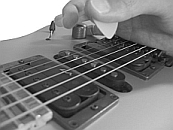Many times a guitarist defines his personal style by using the technique known as muting or string muting. There are a number of ways in which muting can be done. The most commonly used method is the one in which one can hear the note but not the ringing undertone. This technique is done by resting the heel of your picking hand gently on the bridge near the strings. By doing this, the guitar produces a more percussive sound. It is also commonly referred to as the palm mute.

This technique is generally used by players who play in a rhythm section of a jazz band. It gives it more of a blues based quality unlike plain ringing chords. The unused strings are often muted by the lead players in order to maximize the usage of the strings being played. It also helps the players avoid the mistake of playing unnecessary notes (…sometimes less is more).
By doing this, the unwanted strings even if struck by mistake, get stifled. Using your fret hand to mute the string is also a major technique you’ll see if you watch a guitarist perform. It’s different from the palm muting technique but is equally important for effectively and efficiently playing the guitar.
This technique is most useful while using the power chords and when playing other chords as well. The reason behind using the technique of “fret hand muting” is to avoid the use of strings that are not being played in the chord (very important). You’ll tend to see the “fret hand muting” method used more often than the palm muting one. The reason for this is that even if you pick another string while using the fret hand muting, it’ll still produce a quality sound and give your music a new untamed dimension.
But ultimately which one you choose depends on the style of each individual guitar player. So the choice is yours! It’s time for you to decide what sound you’re looking for.







Comments on this entry are closed.